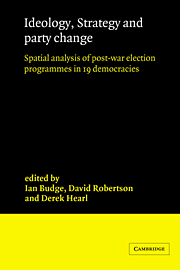 Ideology, Strategy and Party Change
Ideology, Strategy and Party Change Published online by Cambridge University Press: 27 October 2009
PURPOSES OF THE ANALYSIS
Most of this book is concerned with the ‘internal’ analysis of election programmes – the examination, that is, of the concerns and emphases which parties write into their text and which distinguish them from other parties. In Chapter 2 we discuss the background and design of this type of research; Chapters 3–17 apply it to individual countries; and Chapter 18 extends it in a truly comparative, cross-national direction.
The first question people ask in this regard is not, however, what do election programmes tell you about parties, but how far do they get implemented in government? It is the essence of theories of representative democracy that parties gain power on the basis of election pledges which they then have a ‘mandate’ to put into effect (Kavanagh, 1980). If they do not do this, the usual justifications of the system of government would not apply; electors are being defrauded; the system is not functioning as a sensitive way of translating popular preferences into action.
A full investigation of the relationship between programmatic commitments and government reactions is possible only on the basis of an extended examination of what the commitments are and how they are expressed. The bulk of our book describes this preliminary, but essential, investigation. On its basis we are currently examining relationships with (single-party) government policy (Railings, Budge and Hearl (eds.), 1987) and with coalition government programmes (Laver, Budge and Hearl (eds.), 1987).
To save this book to your Kindle, first ensure no-reply@cambridge.org is added to your Approved Personal Document E-mail List under your Personal Document Settings on the Manage Your Content and Devices page of your Amazon account. Then enter the ‘name’ part of your Kindle email address below. Find out more about saving to your Kindle.
Note you can select to save to either the @free.kindle.com or @kindle.com variations. ‘@free.kindle.com’ emails are free but can only be saved to your device when it is connected to wi-fi. ‘@kindle.com’ emails can be delivered even when you are not connected to wi-fi, but note that service fees apply.
Find out more about the Kindle Personal Document Service.
To save content items to your account, please confirm that you agree to abide by our usage policies. If this is the first time you use this feature, you will be asked to authorise Cambridge Core to connect with your account. Find out more about saving content to Dropbox.
To save content items to your account, please confirm that you agree to abide by our usage policies. If this is the first time you use this feature, you will be asked to authorise Cambridge Core to connect with your account. Find out more about saving content to Google Drive.